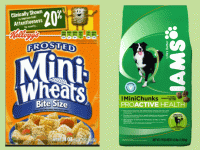Teaching Critical Thinking (with Dog Food)
Your content has been saved!
Go to My Saved Content.Editor's note: Internationally recognized coding expert James Bach dropped out of school at age 16. A few years later, he was one of the youngest hires at Apple Computer. His book Secrets of a Buccaneer-Scholar shows how anyone can create their own education on their own terms.
Bite-Sized Logic
To teach critical thinking, start by bringing a box of Frosted Mini-Wheats to class. Hold it up. Shake it. Ask the kids, "Can you tell me what this is?"
"Cereal! Frosted Mini-Wheats! Mini-Wheats cereal," they will say. Some may call out other answers, even silly ones. Smile about that. Funny, irrelevant and unique responses are all good at this point in the exercise.
"Mini-Wheats?" someone will ask. "What are those? A tiny stalk of wheat?" Begin a conversation about what "frosted" and "bite-sized" mean.
Next, switch gears like so: "Really? This is a box of Mini-Wheats? How sure are you?" Get students to tell you, on a scale of 1 to 10, where 10 is super certain, how confident each learner is that you are holding a box of Mini-Wheats.
Once students have locked in their answers, open the box and pour out the contents into a bowl. What will come out of the box is dry dog food, because before class you replaced the Mini-Wheats with Iams Mini-Chunks.
"Mmmm. Mini-Wheats!" you say.
"Those aren’t Mini-Wheats!"
"But you said they were!" Make sure you sound puzzled and a little hurt. "Want some?"
"No!"
"Why not? Isn't Iams Mini-Chunks close enough? After all, it has the word 'mini' on the bag. If you've seen one mini, you've seen them all, right? Why not eat that for breakfast?"
Draw this dialog out, using the full Socratic treatment, depending on how old the kids are and what kind of energy they may have. This process is probably different for me because I deal mostly with people in their twenties, thirties, forties and fifties. Instead of dog food, we use computer software that is often unfit for a dog. Regardless of age or the props you use, teaching any creative, critical or systems thinking involves one absolute: you must encourage variety and thoughtfulness without fixating on the technical rightness of learners' answers. Otherwise, your students will become frightened of saying anything for fear of being wrong, or else they will become lost in the game of predicting what you want them to say.
Three Useful Words
Critical thinking can be terrifying. But it is vital, because to think critically is to assert suspicion about ideas that everyone else seems to trust. Therefore, convey deeper trust in the method of systematic doubting (and in the judgment of the doubters) than in the sanctity of received wisdom. I am rather uncritical about my support for critical thinkers as they begin to spread their wings. This means I must be patient as I respond to fledgling class lawyers. If I am successful in waking their minds, it is only a matter of hours or days before someone discovers that they can question my authority and competence.
When I tell my software testers that there are no best practices, I must be ready for this pushback: "But aren't you suggesting that belief is a best practice?" An excellent defense against criticism is self-pre-criticism. Fortunately, I question myself so much that I hardly notice when someone else does.
I want you to notice the pattern I used in the exercise above. It’s a three-word critical thinking heuristic: Huh? Really? So? Each word invokes a different pattern of investigation that reveals hidden assumptions, sloppy inferences and misunderstandings.
- Huh?
- Do we understand what is being talked about?
- Is it confusing?
- Vague?
- Is it factually true?
- What hard evidence do we have for it?
- Why does this matter?
- To whom does it matter?
- How much does it matter?
At the end of the exercise, encourage each student to play with those words in order to probe his or her own thinking.
Certain Rules Apply
Incidentally, I did not choose Mini-Wheats arbitrarily. In 2009, Kelloggs was successfully sued by the Federal Trade Commission for the misleading claim that children would "improve attentiveness by nearly 20 percent" by eating Frosted Mini-Wheats. I am confident that today's cereal boxes -- any cereal box -- will include dodgy claims. If I were teaching chemistry, I'd have my students analyze every nutritional and physical claim on a cereal box.
I'll leave you with this thought. A couple of decades ago, when I was a new husband, I analyzed my wife's choice of salad dressing during dinner. I demonstrated that she had committed clear errors of judgment and logic. I was able to do that because I had honed my critical thinking skills for years before settling down into married life. Since that dinner, there has been a rule: James is not allowed to do critical thinking while at home. This has been a good rule as far as I know. I haven't felt the urge to question it.
